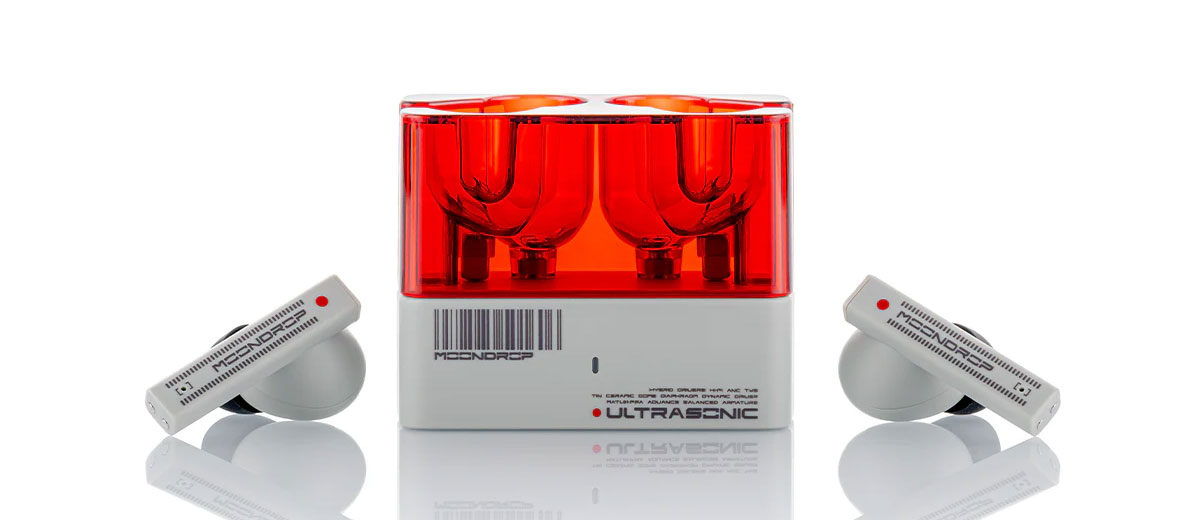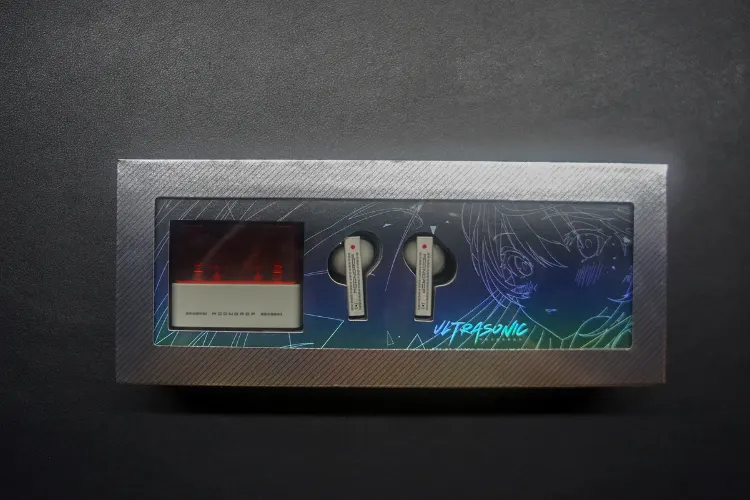Wireless Performance
Pairing
The ULTRASONIC paired quickly and seamlessly with any source device I tried, may it be macOS laptops, Windows computers, iPhones, and Android Smartphones.
However, as I mentioned in the cradle portion of the review, putting the ULTRASONIC into pairing mode is unnecessarily obtuse because of its lack of a dedicated pairing button
However, when simply reconnecting the ULTRASONIC to the same device it previously connected to, it pairs consistently and responds quickly.
Stability and Range
When connected to my phone, the ULTRASONIC maintains a generally stable connection, even as I move around.
Intermittent audio dropouts only occurred when I moved two rooms away, approximately 11 meters, which I found reasonable given the multiple layers of concrete walls separating the rooms.
The signal only fully disconnected when I moved to the lower floor of my house, about 13-15 meters away.
Latency
The ULTRASONIC delivers audio with minimal latency, ensuring a seamless experience during gaming and video playback.
In my usage, I didn’t encounter any noticeable lag or delay. Online latency test videos revealed that the ULTRASONIC achieved an impressive latency of approximately 0.3 milliseconds.
Select Comparisons
MOONDROP Golden Ages
Technical
The MOONDROP Golden Ages comes with a 13mm planar magnetic driver, a similar driver type found in pricier wired IEMs, while the ULTRASONIC makes use of a hybrid driver configuration with a 13mm dynamic driver and a balanced armature driver.
For connectivity, both IEMs support Bluetooth 5.3. with wide range supports for codecs such as SBC, AAC, LDAC, and LC3.
The MOONDROP Golden Ages provide about 4.5 hours of listening time with the earbuds and an additional 14 hours from the charging case, whereas the ULTRASONIC can give up to 5.5 hours on a single charge an additional 13 hours coming from the charging case.
Design
Like previously mentioned, both IEMs share identical earbud designs. The Golden Ages has a much better built plastic cradle with an integrated lid. The ULTRASONIC’s cradle is built out of less premium plastics, with its top half being constructed out of a thin translucent plastic that resembles resin.
Performance
The ULTRASONIC has a deeper more tactile sub-bass compared to the Golden Ages, however the Golden Ages has more sub-bas quantity, playing back kick drums with a stronger sense of emphasis.
The Golden Ages is also a much warmer set of IEMs, giving synths, hums and male vocals a more lush and atmospheric sound within the context of a mix.
The Golden Age’s detail retrieval outclasses that of the ULTRASONIC. Guitars and piano keys in the mid-range are played back with more distinction and micro detail, making the ULTRASONIC sound one dimensional in comparison.
The Golden Age’s planar driver excels in playing back top end treble as well. Chimes and cymbals are presented with drastically better detail on the Golden Ages; however, it also has tendency to come off as more sibilant than the ULTRASONIC.
Apple AirPods 3
Technical
The Apple AirPods 3 feature an Apple-designed dynamic driver paired with a custom “high dynamic range amplifier.” However, specific details about the driver size and amplifier specifications remain unavailable.
In contrast, the MOONDROP ULTRASONIC employs a 13mm dynamic driver alongside a Balanced Armature driver—a hybrid configuration typically found in higher-end audiophile-grade wired IEMs.
For connectivity, the AirPods 3 utilize Apple’s proprietary H1 chip, which ensures a stable Bluetooth 5.0 connection and supports the AAC codec for high-quality audio with compatible devices.
The MOONDROP ULTRASONIC boasts Bluetooth 5.3, providing a more advanced connection with support for a broader range of codecs, including SBC, AAC, LDAC™, and LC3, for superior audio quality.
The AirPods 3 deliver up to 6 hours of listening time per charge, with the MagSafe Charging Case extending total playback to 30 hours.
In comparison, the MOONDROP ULTRASONIC offers around 5.5 hours of listening time on a single charge and an additional 13 hours with its charging case. While this falls short of the AirPods 3, it remains a respectable performance for its class.
Design
The AirPods 3 follow a sleek and minimalist design approach, consistent with Apple’s signature aesthetic. The cradle is made from glossy white plastic with softly curved edges, exuding a simple and understated look that draws little attention—much like the earbuds themselves.
In contrast, the ULTRASONIC features a larger cradle constructed from lighter, less premium-feeling plastic. Its design incorporates linear patterns, along with subtle cyberpunk-inspired fonts and iconography, giving it a more futuristic vibe.
The AirPods 3 earbuds adopt an earbud-style form factor without in-ear tips, resting on the outer ear for a less intrusive fit. The ULTRASONIC opts for a more conventional IEM-style design with in-ear tips for a snugger, more secure fit.
Performance
With its duller, flat sound signature, the AirPods 3 do not hit nearly as deep or as hard as the MOONDROP ULTRASONIC. I would like to re-iterate that I already found the ULTRASONIC to be bass-light in the first place, making this comparison even more surprising.
The sub-bass hits on the ULTRASONICs have good texture and tactility, despite the bass quantity being lacking. However, the AirPods 3’s bass simply sounds one-dimensional and unnatural
Both IEMs have a clean and neutral mid-range presentation. The ULTRASONIC already had decent to sub-par detail retrieval and emphasis for my taste, but the AirPods still falls lower than that.
The AirPods 3 struggle with treble performance, falling short in delivering the same energy and clarity in cymbal playback as the ULTRASONIC.
Also, their treble exhibits harsh peaks and noticeable sibilance, resulting in a listening experience that is significantly more fatiguing compared to the smoother presentation of the ULTRASONIC.
Huawei Freebuds 3
Technical
The Huawei FreeBuds 3 are equipped with a 14mm dynamic driver, which is slightly larger than the MOONDROP ULTRASONIC’s dynamic driver. However, the ULTRASONIC pairs this with an additional Balanced Armature driver for a hybrid setup.
For connectivity, the FreeBuds 3 utilize the Kirin A1 chip, offering a stable Bluetooth 5.1 connection and support for AAC and LDAC codecs to ensure high-quality audio transmission with compatible devices.
The MOONDROP ULTRASONIC uses Bluetooth 5.3, providing a more advanced connection and supporting a broader range of codecs, including SBC, AAC, LDAC, and LC3.
Regarding battery life, the Huawei FreeBuds 3 deliver up to 6 hours of music playback with noise canceling disabled, plus an additional 15 hours when recharged in their cradle.
The MOONDROP ULTRASONIC offers approximately 5.5 hours of listening time on mixed ANC on and of use, with the charging case providing an extra 13 hours of playback.
Design
The Huawei FreeBuds 3 embody a sleek, minimalist design, typical of modern consumer electronics.
Their cradle, crafted from glossy black plastic, features a unique circular shape that gives it a modern and understated appearance. This unobtrusive design complements the earbuds themselves, which share the same polished black glossy finish.
In contrast, the MOONDROP ULTRASONIC takes a different approach with a larger cradle made from lightweight plastic, giving it a less substantial feel. Both the cradle and the IEMs are adorned with subtle prints and iconography, reflecting a futuristic, high-tech aesthetic.
The design philosophies of the earbuds also differ significantly. The FreeBuds 3 use an earbud-style form factor without in-ear tips, allowing them to rest comfortably on the outer ear.
The ULTRASONIC adopts a traditional IEM design with in-ear tips for a snug, secure fit and better sound isolation.
Performance
In contrast to the ULTRASONIC’s more neutral sound signature, the V-shaped tuning of the FreeBuds 3 delivers bass that extends deep into the sub-bass region, offering impressive note weight and impact.
The FreeBuds 3’s bass excels in both tactility and texture, surpassing the ULTRASONIC in these areas. Even when switching the ULTRASONIC to its Club EQ mode, which admittedly lacks punch, the FreeBuds 3’s default tuning provided a more satisfying thump, though this came at the cost of some bass bleed.
In the midrange, the ULTRASONIC outshines the FreeBuds 3 in cleanliness and resolution. The warmth of the FreeBuds 3 muddles lower-mid instruments, reducing fidelity and instrument separation.
This warmth, however, gives male vocals a smoother, richer tone, whereas the ULTRASONIC excels in presenting string and key instruments with better fidelity and emphasis.
The Freebuds 3 delivers a treble that is more energetic and detailed than that of the ULTRASONIC. Given the V-shaped signature of the Freebuds 3 this is expected.
However, as a hybrid IEM with a balanced armature driver, I expected better treble performance from the ULTRASONIC.
My Verdict
As a sub-$100 pair of TWS IEMs, the MOONDROP ULTRASONIC is a jack of all trades and master of none. It does not stand out at any particular trait, nor does it have any sonic deal breakers. It’s neutral tuning is inoffensive, albeit a bit boring.
It does come with some minor issues such as the mind-boggling omission of a cradle pairing button and a built-in cradle lid. But with its ANC and Bluetooth 5.3 connectivity, and decent sonic capabilities, the ULTRASONIC is worth considering for buyers looking for an affordable pair of TWS IEMs
MOONDROP ULTRASONIC Specifications
- Drivers: 1DD+1BA
- Bluetooth Version: 5.3
- Codec Support: SBC/AAC/LDAC™/LC3
- Charging Port: USB-C
- Working Distance: Approximately 10 meters (in an unobstructed open environment)
- Earphone Charging Time: About 1 hour





